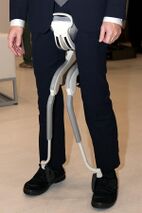Engineering:Robot leg

A robot leg (or robotic leg) is a mechanical leg that performs the same functions that a human leg can. The robotic leg is typically programmed to execute similar functions as a human leg. A robotic leg is similar to a prosthetic leg. However, a robotic leg can be controlled electrically or mechanically. To have the robotic leg emulate human leg behaviors, surgeons must redirect the nerves that previously controlled some of the person’s lower-leg muscles to cause the thigh muscles to contract. Sensors embedded in the robotic leg measure the electrical pulses created by both a re-innervated muscle contraction, and the existing thigh muscle.[1]
Mechanism
A robotic Leg attaches to an individual who has had a lower extremity amputation—of a portion of a leg or foot. Doctors and technicians measure the remaining limb structure and of the person’s prosthesis to ideally fit the robotic leg.[2] After they attach the robotic leg, they embed the sensors in the robotic leg that measure the electrical activity created by re-innervated muscle contraction, and existing thigh muscle.
Applications
Robotic legs have become a popular target of research and development in the past few years. Robotic legs can be applied to people who have had limb amputating surgery caused by a major trauma, or a disease like cancer. Robotic legs have also seen much applicable use in military combat injuries. Massachusetts Institute of Technology (MIT) has been working to create a “bionic” or robotic leg that can function as if it had organic muscles.[3]
References
See also
- Robot arm
- Legged robot
 |



